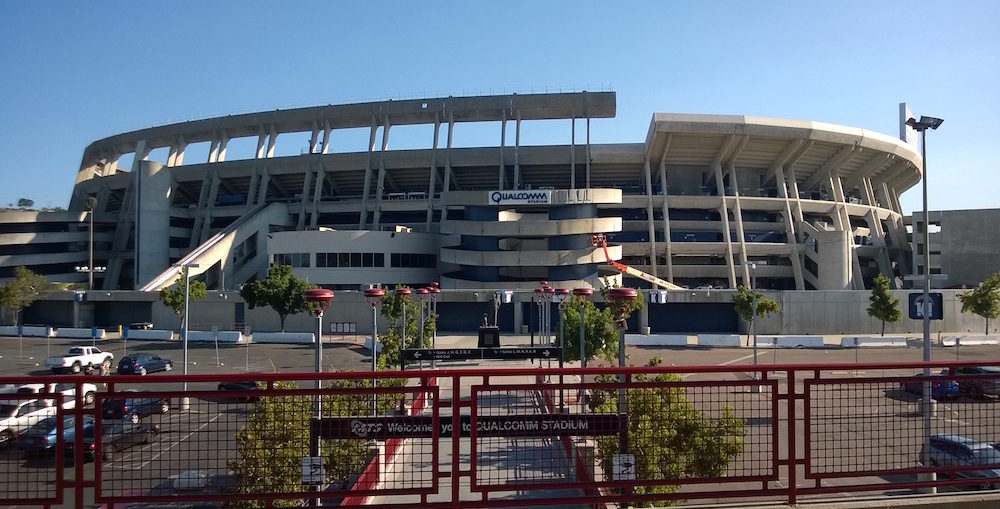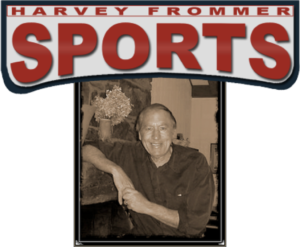

A lot of twists and turns, evolution and revolution, mistakes and major steps forward, colorful characters, dedicated idealists and guys with an eye on making a quick buck, – all of these and much more were part of the mix in the history of professional football before it would finally find solid footing and great success on the landscape of sports in the United States and become a global phenomenon.
It was not until August 20, 1920, at a meeting in Canton, Ohio at the Jordan and Hupmobile Auto Showroom of the owner of the Canton Bulldogs that a semblance of professional football as we know it came to be.
At the meeting were seven men including the legendary Jim Thorpe who would become the organization’s first president. There were delegates from the Bulldogs, the Akron Pros, the Cleveland Indians and Dayton Triangles. They formed the new league – the American Professional Football Conference. One hundred dollars was the announced membership fee for that first season. It was reported that none of those original teams actually paid what was then considered a hefty fee.
The initial teams had a decidedly small town and Midwestern feel: Akron Professionals, Canton Bulldogs, Chicago Cardinals, Cleveland Tigers, Dayton Triangles, Decatur Staleys, Hammond Pros, Rochester (N.Y.) Jeffersons, Rock Island (Ill.) Independents, and Muncie Flyers.
Teams would come and go over the league’s first years. The idea of organized football was appealing, but there was a lot of challenge, work and money involved. Only four clubs survived that first season of 1920: Akron, Buffalo, Canton, and Decatur.
From the start, African-Americans were playing pro football. In 1920, Fritz Pollard, a standout halfback at Brown and an All-American, starred for the Akron Pros. He and Bobby Marshall were the NFL’s first black players. The next year Pollard became the league’s first black head coach. He also maintained his position as one of the best players in pro football.
Approximately 13 African-American players appeared on NFL rosters between 1920 and 1933. Paul Robeson, who would gain great fame as a great singer, actor, civil rights leader, was encouraged by Pollard to play for Akron in 1921. The following year Robeson had a stint with Milwaukee. Playing football enabled the powerful athlete to pay his way through Columbia University Law School.
In 1920, the Decatur Staleys had a net profit of $1,800. All 22 members of the team shared in the profits. “We practiced every afternoon, six days a week on a very well kept baseball field owned by the Staley Company.” (Frommer, 187).
The next year the Decatur franchise moved to Chicago after being sold to player-coach George Halas, who went on to become one of the most important figures in the first half century of pro football. Halas gave the Staleys a new name — the Chicago Bears.
On June 24, 1922, the American Professional Football Conference was renamed the National Football League. Doing that eliminated the organization’s unwieldy name and its evocation of a soccer league.
By the mid-1920s, the struggling and cumbersome NFL included 25 teams each experiencing varying degrees of success and hardship. On April 23, 1927, in a season where professional baseball was king and the New York Yankees of Murderers Row were the talk of the town, the NFL made some tough decisions. All weak and struggling franchises were dropped. The NFL shrunk from 22 franchises to 12. It also moved away from its Midwestern roots. The focus now would be placing teams in populous cities in the east to solidify the league, make it more financially solvent.
In 1932, the NFL recorded official statistics for the first time. That was a good thing. A bad thing was the behavior of racist George Preston Marshall who made his money in the commercial laundry business. Using some of that cash, he became the owner of the Boston football team. Marshall convinced other NFL owners to institute a policy of total racial segregation. They didn’t have to heed the suggestions of a bigot, but they did. No blacks played in the NFL between 1933 and 1946.
Marshall moved his Boston Redskins to Washington in 1937. Born in segregated West Virginia, the Redskins owner opposed adding blacks to his team’s roster claiming that would alienate fans. “We’ll start signing Negroes when the Harlem Globetrotters start signing whites,” he snapped.
By 1962, the Globetrotters still did not have whites, and the Redskins still had not fielded a black player for decades. Change, however, loomed. The Interior SecretaryStewart Udall in President John F. Kennedys’ cabinet, said he would evict the Redskins from publicly funded D. C. Stadium if a black player was not signed. Marshall gave in.
Ernie Davis, the black Syracuse running back and Heisman Trophy winner was picked Number One in the draft by the Washington Redskins. A week later Davis was traded to Cleveland for Bobby Mitchell and Leroy Jackson, plus John Nisby was signed and Ron Hatcher was drafted. The NFL (and the ‘Skins with four for a time) now had at least one African American player on each team. Sadly, Ernie Davis never played in the NFL. He died in 1963 of leukemia.
Although the NFL draft started in 1939, no franchise selected an African-American player until 1949. Even during World War II, when the NFL was so shorthanded, no blacks needed to apply. They knew bigotry barred the door for them… Demand for able-bodied men for the war effort depleted NFL rosters. Many non-prime -time players were brought in. Teams reduced rosters by five players to help survive. In 1943, The Steelers of Pittsburgh and the Eagles of Philadelphia became the Phil-Pitt Steeler-Eagles, called “Steagles” by fans. The Chicago Cardinals and Steelers merged in 1944 in 1945 as Card-Pitt, a team so mediocre, its own fans called it “Carpets.” Brooklyn and Boston franchises fused in 1945 becoming “Yanks.”
Jack Roosevelt Robinson in 1939 at UCLA led the nation in rushing, a dozen yards a carry. The NFL was segregated. Major League Baseball was segregated. So the man they called “Robby” played in the Negro Leagues. And then with the help of Branch Rickey in 1947, Robinson shattered baseball’s color line as a member of the Brooklyn Dodgers. There is no telling how good a player he would have been in the NFL, but all estimates are that he would have been very good.
The all white NFL Cleveland Rams moved to Los Angeles in 1946. Their plan was to play games in the Memorial Coliseum, a venue supported with public funds, one which could not be leased to a segregated team. Under pressure, the Rams signed former UCLA standouts running back Kenny Washington and receiver Woody Strode. Both had been teammates of Jackie Robinson at UCLA. It was reported that all hell broke loose at the signing among NFL owners. The signing was revolutionary. Washington and Strode were the first African-American players after 13 years of whites-only in the NFL.
The Chicago Bears were a whites-only team their first 32 seasons. Although the New York Giants came into being in 1925, the first blacks they signed were in 1948. Pittsburgh’s Steelers featured only white players from 1934 until 1952.
On October 22, 1939, the first televised professional football game was transmitted in the New York City area. NBC broadcast a game between the Brooklyn Dodgers and Philadelphia Eagles at Ebbets Field. According to the Pro Football Hall of Fame, there were 500 television sets in the Big Apple then and 13,050 fans attended the game. Nevertheless, that primitive beginning foreshadowed the future of promise.
Early technology was primitive. “Television was a child of radio.” Said Curt Gowdy. “We used one or two cameras, and we thought that was something.”
At the start television positively affected the game’s popularity. Then the new medium had a negative effect on game attendance. In 1950, the Rams televised all games – home and away. Attendance plummeted. The next year, lesson learned, the Rams televised just road games. Attendance boomed to over 234,000. Lesson learned. In 1953, the courts upheld the NFL’s right to black out home games.
Commissioner Bert Bell allowed only the broadcasting of road games explaining: “When you televise a road game, you are getting free advertising. When you televise a home game, you are competing with your own ticket sales. The home gate must be protected or the game will die. You can’t sell what you give away free.”
HOWARD COSELL: The blackout was the single most important thing. You don’t give your product away. Football used television properly.
A major turning point in the history of professional football took place at Yankee Stadium on December 28, 1958. In a game broadcast nationally by NBC, the New York Giants matched up against the Baltimore Colts. Against a backdrop of temperatures in the high 40s, Baltimore kicker Steve Myhra powered a 20-yard field goal to make the score 17-17 and send it into sudden death overtime. That had never taken place before in NFL championship game history. A touchdown by Baltimore’s Alan Ameche gave the Colts a 23-17 triumph.
The thrills and suspense of that competition and mesmerizing effect on the millions who watched it play out-earned the contest the label: the “Greatest Game Ever Played.”One of the viewers of that game was Lamar Hunt whose father Haroldson Lafayette Hunt was the founder of Hunt Oil and one of then one of the wealthiest men in the world.
The young Hunt, an heir to his father’s billions, had cast about for months jockeying back and forth and trying to make up his mind about whether to attempt to purchase a major league baseball franchise or a pro football team. By game’s end, Lamar Hunt was sure.
One of the stars of the “Greatest Game Ever Played” was New York Giants running back, Frank Gifford. He remembers what it was like.
FRANK GIFFORD: After the game, the sport had it made. There were stories in the media. Advertisers became really interested in football, the networks cared. That game enabled the sport to self-generate itself nationally.
All of a sudden a line of businessman got into the act seeking to own a team of their own in the National Football League.
(to be continued*)
Much of the piece is excerpted from Harvey Frommer’s acclaimedWhen It Wass Just a Game.
About Harvey Frommer
One of the most prolific and respected sports journalists and oral historians in the United States, author of the autobiographies of legends Nolan Ryan, Tony Dorsett, and Red Holzman, Dr. Harvey Frommer is an expert on all major sports. Cited by the Congressional Record and by the New York State Legislatiure as a sports journalist and historian, a professor now for more than two decades in the MALS program at Dartmouth College, Frommer was dubbed “Dartmouth’s Mr. Baseball” by their alumni magazine. He’s the founder of www.HarveyFrommerSports.com.
Mint, signed, discounted Frommer books are available from his site.
